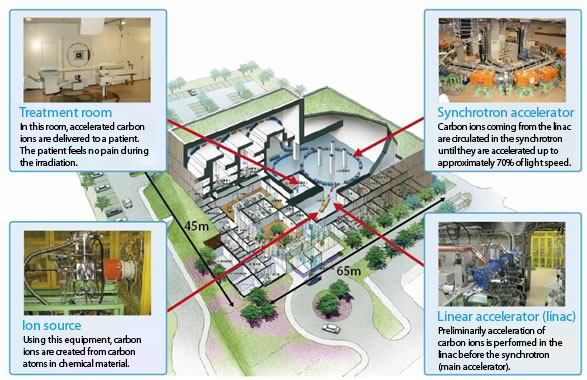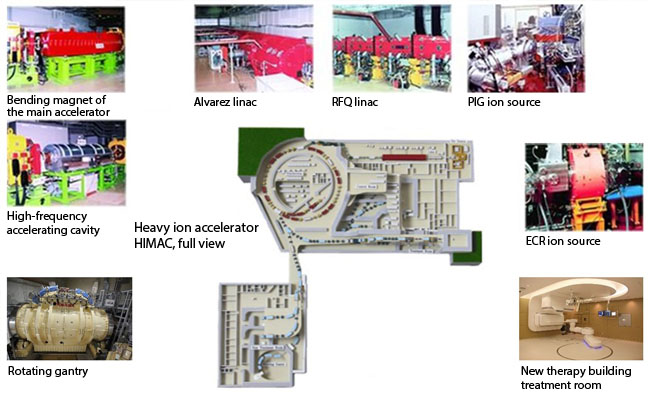
- What is heavy ion radiotherapy?
- Heavy ion radiotherapy facility
Heavy ion radiotherapy facility
For the sake of more cancer patients: Great advances in worldwide use
Mechanisms of the system dedicated to heavy ion radiotherapy
In order to prepare heavy ion beams (carbon, silicon, argon, etc.) for cancer therapy, the atoms are deprived of some electrons in the ion source, and are accelerated with a linear accelerator (linac) to approximately 10% of light speed, and passed through a carbon film in order to remove all the remaining electrons. Using a high-frequency electrical field, the ions are circulated several hundred thousand times in a synchrotron, and they are accelerated up to approximately 70% of light speed for treatment. Then we can use them for treatment.
A compact heavy ion radiotherapy facility for worldwide use: Gunma University Heavy Ion Medical Center
In the past, even though it was hoped that heavy ion radiotherapy would serve as a treatment for intractable cancer, the facility required land as large as a soccer pitch and considerable construction expenses. Because of this significant problem, R&D for the downsizing of the accelerator was advanced. The energy of the heavy ion beam was optimized by the experience of HIMAC, and various devices were improved by the latest technology. As a result, the necessary area was successfully reduced to about one-third that of the HIMAC, and the construction and operation expenses were successfully reduced to a large extent. The first compact heavy ion radiotherapy facility for worldwide use was completed on Gunma University campus, and it started heavy ion radiotherapy in 2010.
The Gunma University heavy ion radiotherapy facility is approximately 45 by 65 meters in area and approximately 20 meters in height. This building contains a 20-meter-diameter synchrotron accelerator, where carbon ions are accelerated up to approximately 70% of light speed; three treatment rooms; and associated equipment. This compact heavy ion radiotherapy facility is attracting international attention as a great step forward for the worldwide use of heavy ion radiotherapy.

HIMAC: The world's first accelerator dedicated to heavy ion radiotherapy
HIMAC (Heavy Ion Medical Accelerator in Chiba), the world's first accelerator dedicated to heavy ion radiotherapy, was completed in National Institute for Quantum and Radiological Science and technology (QST) the National Institute of Radiological Sciences (Chiba, Japan), which established Japan's international position in the field of the research and clinical application of heavy ion beams. There are three treatment rooms where heavy ion beams come from vertical and horizontal ports so as to be used efficiently. The treatment room E and F have both vertical and horizontal ports from which beams can be emitted at the same time. The room G has new superconductive Gantry which is used for therapy for patient’s convenience during treatment.
HIMAC was the first heavy ion radiotherapy facility in Japan, and was constructed as part of the national First-Term Comprehensive Ten-Year Strategy for Cancer Control. The clinical trials of HIMAC started in 1994, and about 12,000 cancer patients have already been treated ( as of March 2019). Thus, HIMAC has been playing an important role as a national research facility.

3D scanning irradiation treatment and rotating gantry
i-ROCK constructed the New Treatment Building to further upgrade 3D scanning irradiation treatment and reduce the burden on patients. In May 2011, 3D scanning irradiation treatment (clinical testing) began in this building.
In addition, the heavy ion rotating gantry was made more compact and lightweight, and the world's first rotating gantry equipped with superconducting magnets was realized.
[Reference data] National Institutes for Quantum and Radiological Science and Technology, National Institute of Radiological Sciences














